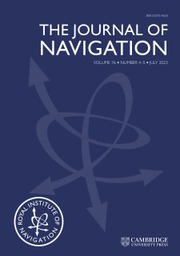No CrossRef data available.
Article contents
Software package for nautical astronomy
Published online by Cambridge University Press: 01 October 2025
Abstract
The article is devoted to the mathematical theories and algorithms necessary for the implementation of a software package that fully automates the calculations necessary in Nautical Astronomy. The article describes a method for calculating the equatorial and horizontal coordinates of the celestial bodies at any moment of time. The authors describe the calculation of the time of the apparent rising (setting) of the Sun, solar illumination and events of other celestial bodies. A formula for calculating astronomical refraction is proposed. A matrix method for implementing the method of least squares for determining the coordinates of a place along the lines of position is described. An algorithm for identifying navigational planets is also described and a method for estimating the error for it is proposed. Based on this, the results of the development of the software package ‘Astronomy Package’ for Nautical Astronomy are presented.
Keywords
Information
- Type
- Research Article
- Information
- Copyright
- © The Author(s), 2025. Published by Cambridge University Press on behalf of The Royal Institute of Navigation


